
Click the above Computer Enthusiasts to follow us
Intel once attempted to integrate X86 architecture processors (Atom) into mobile devices represented by smartphones and tablets, but ultimately failed.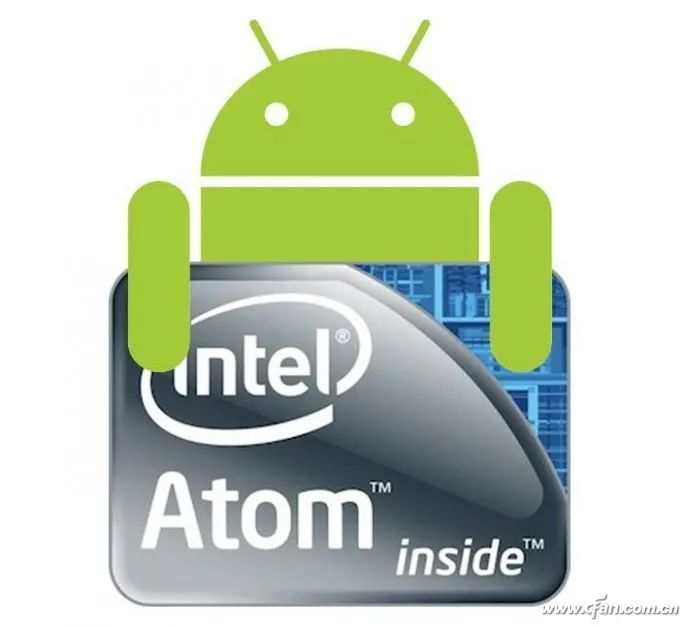 As the saying goes, “If you come, you must reciprocate.” Since Intel could bring X86 over, ARM can naturally retaliate.Thus, we have seen Microsoft’s own Surface RT, as well as laptops customized by Microsoft in collaboration with Qualcomm. The biggest feature of these devices is that they are equipped with ARM architecture processors, competing for a share of the “productivity” market.
As the saying goes, “If you come, you must reciprocate.” Since Intel could bring X86 over, ARM can naturally retaliate.Thus, we have seen Microsoft’s own Surface RT, as well as laptops customized by Microsoft in collaboration with Qualcomm. The biggest feature of these devices is that they are equipped with ARM architecture processors, competing for a share of the “productivity” market.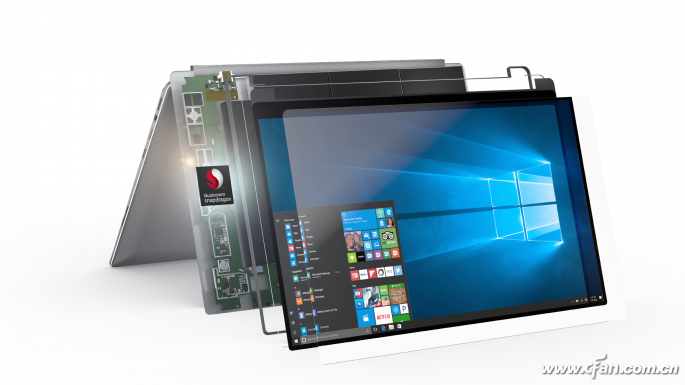 Currently, the most promising leader for the ARM camp is Apple. According to the latest news, Apple will release the Apple Silicon MacBook on November 11, which features Apple’s own A14X chip, based on a 5nm process, touted as the strongest version of the A14 processor, claiming performance comparable to Intel’s eight-core Core i9, while also offering lower power consumption and a more attractive price.
Currently, the most promising leader for the ARM camp is Apple. According to the latest news, Apple will release the Apple Silicon MacBook on November 11, which features Apple’s own A14X chip, based on a 5nm process, touted as the strongest version of the A14 processor, claiming performance comparable to Intel’s eight-core Core i9, while also offering lower power consumption and a more attractive price. The question arises: Apple’s Mac series PCs are still relatively niche, and not everyone has the strong R&D capabilities and financial support like Apple. To create chips that can match the performance of contemporaneous X86 processors, they still need the coordination of the big brother ARM.The good news is that ARM has recently launched a core architecture specifically optimized for PC devices—the Cortex-A78C.
The question arises: Apple’s Mac series PCs are still relatively niche, and not everyone has the strong R&D capabilities and financial support like Apple. To create chips that can match the performance of contemporaneous X86 processors, they still need the coordination of the big brother ARM.The good news is that ARM has recently launched a core architecture specifically optimized for PC devices—the Cortex-A78C. In May, ARM released the “Three Musketeers” consisting of Cortex-X1, Cortex-A78, and Mali-G78 (see Cortex-A78, X1, Mali-G78 Released! Full Analysis of ARM’s Three Musketeers). The Cortex-A78C is an enhanced version of the earlier Cortex-A78.Cortex-A78 OverviewLet’s review the Cortex-A78, which is ARM’s successor to the Cortex-A77 released in 2019. Although it retains the Austin microarchitecture (based on the ARM v8.2 instruction set), it upgrades the branch predictor, allowing it to handle two predictions in one clock cycle (the previous Cortex-A77 could only handle one), thus improving core throughput; the Cortex-A78 increases the width of the instruction scheduler from 10μops in the Cortex-A77 to 12μops; it also enhances the bandwidth of the cache subsystem.
In May, ARM released the “Three Musketeers” consisting of Cortex-X1, Cortex-A78, and Mali-G78 (see Cortex-A78, X1, Mali-G78 Released! Full Analysis of ARM’s Three Musketeers). The Cortex-A78C is an enhanced version of the earlier Cortex-A78.Cortex-A78 OverviewLet’s review the Cortex-A78, which is ARM’s successor to the Cortex-A77 released in 2019. Although it retains the Austin microarchitecture (based on the ARM v8.2 instruction set), it upgrades the branch predictor, allowing it to handle two predictions in one clock cycle (the previous Cortex-A77 could only handle one), thus improving core throughput; the Cortex-A78 increases the width of the instruction scheduler from 10μops in the Cortex-A77 to 12μops; it also enhances the bandwidth of the cache subsystem.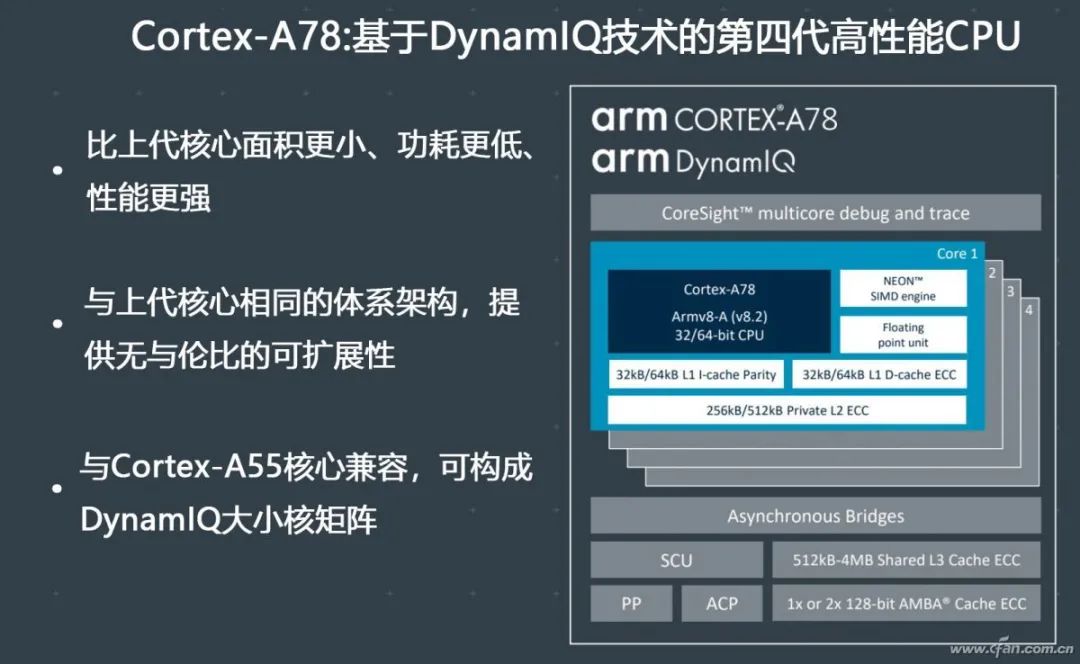 In summary, there are many improvements to the microarchitecture of the Cortex-A78, which we will not detail here. ARM has a clear positioning for the Cortex-A78, aiming to balance the PPA (Power, Performance, and Area) metrics as much as possible.
In summary, there are many improvements to the microarchitecture of the Cortex-A78, which we will not detail here. ARM has a clear positioning for the Cortex-A78, aiming to balance the PPA (Power, Performance, and Area) metrics as much as possible.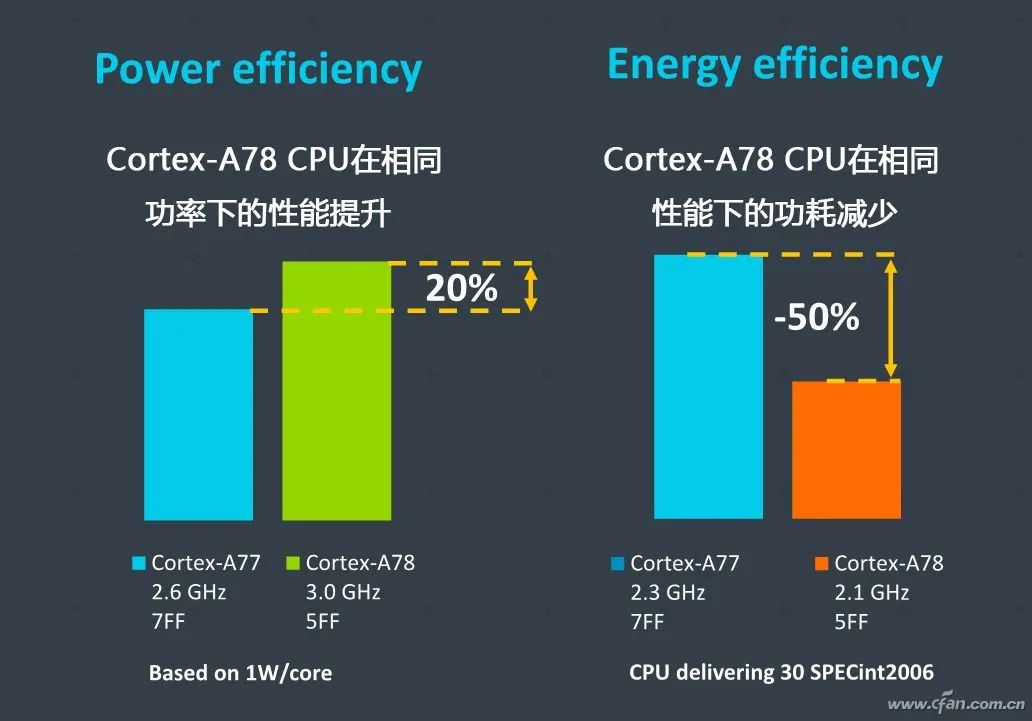 According to ARM’s official data, if the power of a single large core in the SoC is set to 1W, the Cortex-A77 produced with a 7nm process can run at 2.6GHz, while the Cortex-A78 produced with a 5nm process can reach 3GHz, achieving a 20% performance improvement at the same power consumption. Conversely, the performance of the Cortex-A78 at a frequency of 2.1GHz is comparable to that of the Cortex-A77 at 2.3GHz, but the former has a 50% reduction in power consumption.Changes in Cortex-A78CAs an enhanced version of the Cortex-A78, the Cortex-A78C is optimized for high-performance computing, primarily serving high-performance IP for products like laptops. It maintains architectural consistency with the Cortex-A78, with the most significant change being the increase of the L3 cache from a maximum of 4MB to 8MB, catering to higher loads in 3A gaming or productivity multi-threaded application scenarios. Additionally, it has been updated in terms of data and device security, further enhancing device security.
According to ARM’s official data, if the power of a single large core in the SoC is set to 1W, the Cortex-A77 produced with a 7nm process can run at 2.6GHz, while the Cortex-A78 produced with a 5nm process can reach 3GHz, achieving a 20% performance improvement at the same power consumption. Conversely, the performance of the Cortex-A78 at a frequency of 2.1GHz is comparable to that of the Cortex-A77 at 2.3GHz, but the former has a 50% reduction in power consumption.Changes in Cortex-A78CAs an enhanced version of the Cortex-A78, the Cortex-A78C is optimized for high-performance computing, primarily serving high-performance IP for products like laptops. It maintains architectural consistency with the Cortex-A78, with the most significant change being the increase of the L3 cache from a maximum of 4MB to 8MB, catering to higher loads in 3A gaming or productivity multi-threaded application scenarios. Additionally, it has been updated in terms of data and device security, further enhancing device security. For mobile-specific SoCs, the Cortex-A78 mainly plays the role of a large core. To balance performance and power consumption, chip manufacturers often adopt a tri-cluster scheme of 1 Cortex-X1 + 3 Cortex-A78 + 4 Cortex-A55 or 1 high-frequency Cortex-A78 + 3 mid-frequency Cortex-A78 + 4 Cortex-A55, or a dual-cluster scheme of 4 Cortex-A78 + 4 Cortex-A55, where the number and frequency of large cores restrict overall performance output.
For mobile-specific SoCs, the Cortex-A78 mainly plays the role of a large core. To balance performance and power consumption, chip manufacturers often adopt a tri-cluster scheme of 1 Cortex-X1 + 3 Cortex-A78 + 4 Cortex-A55 or 1 high-frequency Cortex-A78 + 3 mid-frequency Cortex-A78 + 4 Cortex-A55, or a dual-cluster scheme of 4 Cortex-A78 + 4 Cortex-A55, where the number and frequency of large cores restrict overall performance output.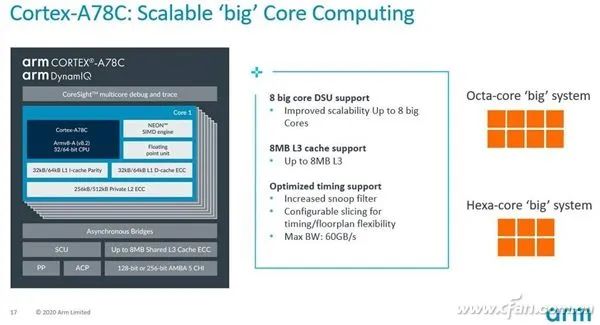 As a core customized for the PC field, chip manufacturers can configure up to 6 Cortex-A78C or an 8-core pure large core scheme of Cortex-A78C, combined with the latest 5nm process technology, achieving a 3.0GHz main frequency. The theoretical performance of an 8-core Cortex-A78C processor should surpass that of Apple’s A14X, but how to balance high performance and high power consumption will depend on the design capabilities of chip manufacturers and device vendors.
As a core customized for the PC field, chip manufacturers can configure up to 6 Cortex-A78C or an 8-core pure large core scheme of Cortex-A78C, combined with the latest 5nm process technology, achieving a 3.0GHz main frequency. The theoretical performance of an 8-core Cortex-A78C processor should surpass that of Apple’s A14X, but how to balance high performance and high power consumption will depend on the design capabilities of chip manufacturers and device vendors.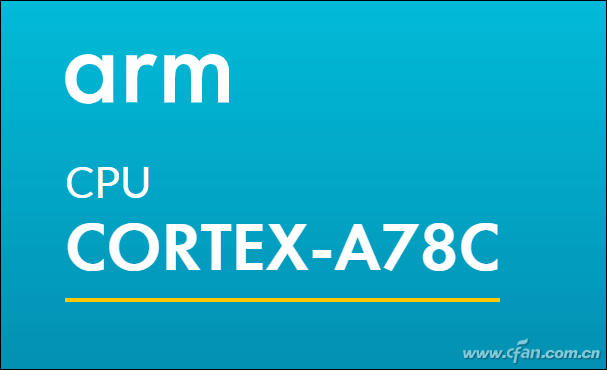 In summary, with the launch of the Apple Silicon MacBook, it should be enough to change the general consumer’s perception of ARM architecture PCs and further accelerate the transformation of ARM architecture Windows PCs. Now ARM has provided “ammunition” represented by the Cortex-A78C; it remains to be seen which chip manufacturers like Qualcomm, Samsung, or MediaTek will be the first to adopt it.
In summary, with the launch of the Apple Silicon MacBook, it should be enough to change the general consumer’s perception of ARM architecture PCs and further accelerate the transformation of ARM architecture Windows PCs. Now ARM has provided “ammunition” represented by the Cortex-A78C; it remains to be seen which chip manufacturers like Qualcomm, Samsung, or MediaTek will be the first to adopt it.

Click “Read the original” for more exciting content